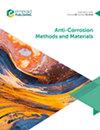Analysis of inhibitory properties of neodymium tartrate and comparison with neodymium chloride for mild steel in neutral sodium chloride solution
IF 2.6
4区 材料科学
Q2 METALLURGY & METALLURGICAL ENGINEERING
引用次数: 1
Abstract
Purpose This paper aims to investigate the eco-friendly neodymium tartrate (NdTar) inhibitor for mild steel in sodium chloride (NaCl) solution. Design/methodology/approach The mild steel 1010 coupon was considered for the current study. Weight loss and the electrochemical methods were used to evaluate the inhibitory effects of neodymium chloride (NdCl 3 ) and NdTar on mild steel in NaCl solution. Scanning electron microscopy, energy-dispersive X-ray analysis and attenuated total reflectance-Fourier transform infrared spectroscopy measurements were carried out to study the morphology and composition of the film, nature of deposits and corrosion products formed in test media on the corroded steel, with the objective of further analyzing the observed behavior of the two inhibitors. Findings Of the two, NdTar performs better than NdCl 3 because it shields mild steel surfaces for longer. According to the results, when NdCl 3 is present in a corrosive solution, the protective film only comprises Nd/Fe oxide/hydroxide/carbonate. However, when neodymium is coupled with the tartrate group (an organic group) and then added to the NaCl solution, the inhibitor film comprises both bimetallic complexes (Fe-Tar-Nd) and metal oxide/hydroxide/carbonate, which results in a more compact film and has higher inhibition efficiency. Originality/value This study evaluated the combined effects of inorganic and organic inhibitors with those of an inorganic inhibitor used alone for mild steel in NaCl solution.酒石酸钕在中性氯化钠溶液中对低碳钢的抑制性能分析及与氯化钕的比较
目的研究环保型酒石酸钕(NdTar)在氯化钠(NaCl)溶液中对低碳钢的缓蚀剂。设计/方法/方法本研究考虑使用低碳钢1010钢板。采用失重法和电化学法评价了氯化钕(ndcl3)和NdTar在NaCl溶液中对低碳钢的抑制作用。通过扫描电子显微镜、能量色散x射线分析和衰减全反射-傅里叶变换红外光谱测量,研究了腐蚀钢表面薄膜的形貌和组成、沉积物的性质以及在测试介质中形成的腐蚀产物,进一步分析了两种抑制剂的观察行为。在这两种材料中,NdTar比ndcl3性能更好,因为它对低碳钢表面的屏蔽时间更长。结果表明,当ndcl3存在于腐蚀溶液中时,保护膜仅由Nd/Fe氧化物/氢氧化物/碳酸盐组成。而将钕与酒石酸盐基团(有机基团)偶联后加入到NaCl溶液中,阻垢膜中既有Fe-Tar-Nd双金属配合物,也有金属氧化物/氢氧化物/碳酸盐,膜层更致密,阻垢效率更高。本研究评估了无机和有机抑制剂在NaCl溶液中对低碳钢的综合效果,以及单独使用无机抑制剂的效果。
本文章由计算机程序翻译,如有差异,请以英文原文为准。
求助全文
约1分钟内获得全文
求助全文
来源期刊

Anti-corrosion Methods and Materials
工程技术-冶金工程
CiteScore
2.80
自引率
16.70%
发文量
61
审稿时长
13.5 months
期刊介绍:
Anti-Corrosion Methods and Materials publishes a broad coverage of the materials and techniques employed in corrosion prevention. Coverage is essentially of a practical nature and designed to be of material benefit to those working in the field. Proven applications are covered together with company news and new product information. Anti-Corrosion Methods and Materials now also includes research articles that reflect the most interesting and strategically important research and development activities from around the world.
Every year, industry pays a massive and rising cost for its corrosion problems. Research and development into new materials, processes and initiatives to combat this loss is increasing, and new findings are constantly coming to light which can help to beat corrosion problems throughout industry. This journal uniquely focuses on these exciting developments to make essential reading for anyone aiming to regain profits lost through corrosion difficulties.
• New methods, materials and software
• New developments in research and industry
• Stainless steels
• Protection of structural steelwork
• Industry update, conference news, dates and events
• Environmental issues
• Health & safety, including EC regulations
• Corrosion monitoring and plant health assessment
• The latest equipment and processes
• Corrosion cost and corrosion risk management.
 求助内容:
求助内容: 应助结果提醒方式:
应助结果提醒方式:


